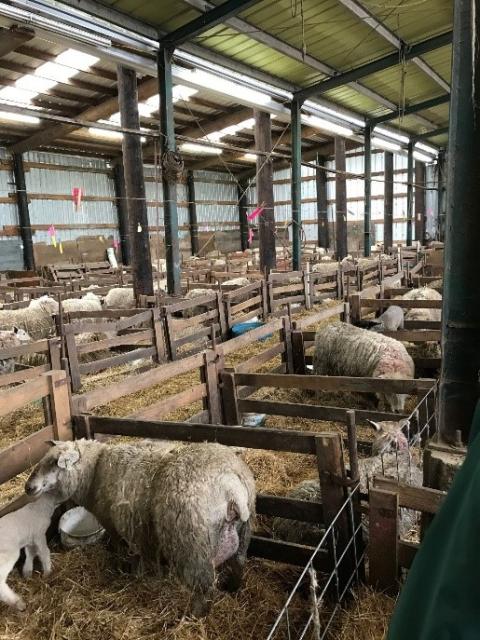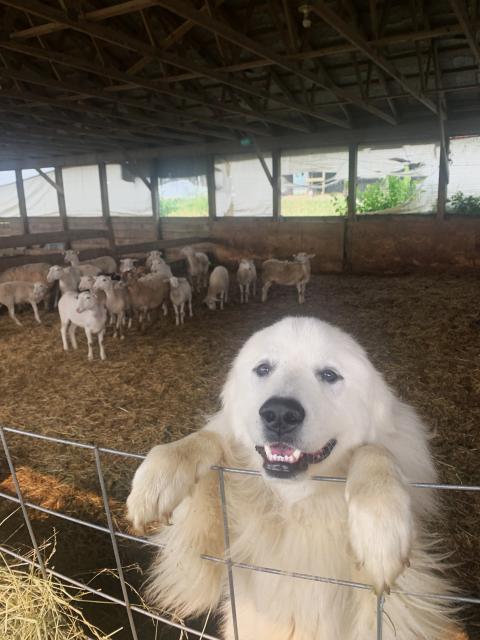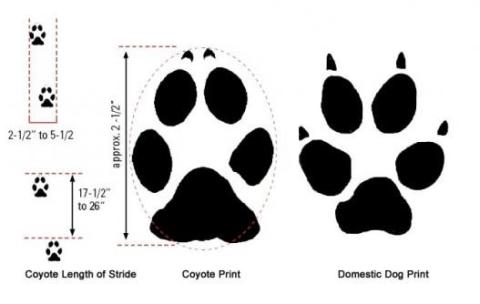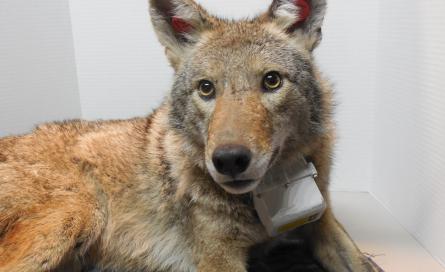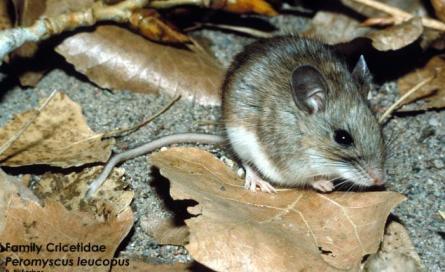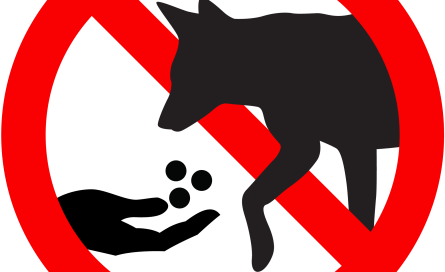Coyotes play an important ecological role across Ohio by regulating populations of small mammals and other carnivores. However, living among coyotes can pose challenges for livestock producers, especially during the lambing and calving season.
Livestock production is a risky business and losing animals can mean serious financial hardship. Though the majority of livestock loss is disease or weather related, reports of predation are common in Ohio. According to the USDA's National Agriculture Statistics Service, in 2011 over 53,000 head of Ohio livestock were lost to predation. Identifying the depredating species is often difficult, if not impossible, but sheep and goat loss across the United States is typically attributed to coyotes.
Husbandry
How a flock or herd is managed depends on time, money, and space constraints. In most cases, changes to animal husbandry can greatly reduce the risk of predation on livestock, but not all of these practices are feasible for all scales of operation.
Night penning. If the space is available, bringing livestock into a pen or secure area closer to barns or other buildings at night is one of the best ways to reduce the risk of predation. If no indoor or secure area is available, night gathering (wherein animals are brought together in a confined area) is an alternative. Night gathering works especially well in conjunction with livestock guardian animals.
Shed/Indoor lambing, kidding, or calving. This practice has become very common, especially with sheep and goats, for its many benefits. In addition to making sure you have access to young if needed, the young also have reduced exposure to parasites, harsh weather, and predators.
Disposal of deceased livestock. Appropriately disposing of carcasses to prevent scavenging is paramount. Coyotes are frequent scavengers and will take advantage of a livestock carcass that is not disposed of properly, as will other mammalian and avian scavengers. Avoid teaching coyotes that your farm is a source of food by burying, burning, or otherwise disposing of carcasses as soon as possible.
Out-of-season lambing, kidding, or calving. Technological advances and the use of hormones have made it possible to induce reproduction in times of the year that livestock would not otherwise breed. This can lead to more favorable timing of young, whether for better weather/pasture conditions or to reduce risk of predation. Studies have shown that the majority of coyote attacks on livestock occur during the spring, when coyotes are providing food for new pups. By preventing the overlap in timing of young livestock with this period when coyotes are also provisioning young, predation risk is greatly reduced.
Deterrents
Decades of research have assessed the effectiveness of different strategies for preventing livestock loss to coyotes, but studies are often plagued by a variety of challenges. Most relevant to producers in Ohio, there has been very little scientific work investigating coyote deterrents outside of the western US. Since our Ohio landscapes are much different than those in Utah or Arizona, for example, we would expect that our coyotes behave differently and may respond to deterrents in a different way.
Even so, deterrents might still be effective at preventing conflict with a variety of predators. Although no method is guaranteed, some practices employed strategically can help reduce the likelihood of livestock loss. Producers who use a combination of these methods will likely have the most success. Knowing how to reduce the risk of predation, what to look for when an animal is attacked or goes missing, and who to contact in the event of predation are all important considerations to protect livestock.
Livestock Guardian Animals
Livestock guardian animals can be very effective in reducing losses from predation, especially if flocks and herds are on open range or in large pastures. Although these animals have great potential, they do cost money, time, and training effort. They can also pose a danger to the livestock themselves if not acclimated to the flocks or herds. Choosing the right animal for each producer's situation and needs will make a difference in preventing predation. Animals that can be effective as guardians include:
- Dogs (Akbash, Great Pyrenees, Anatolian Shepherd, Komondor, and other breeds)
- Llamas
- Donkeys
These animals have their own needs and limitations that should be considered before choosing one as a guardian animal.
Livestock guardian dogs can vary in effectiveness based on breed, upbringing, and individual temperament. Wildlife Services (USDA APHIS) has provided this booklet for more information on guardian dogs.
Fencing
Fencing has been shown to be an important factor preventing coyotes from getting your livestock. It is difficult to exclude coyotes from pastures using traditional fencing. However, fencing that is properly installed, with the bottom the fence touching the ground, and routinely cleared of vegetation is recommended.
Wire-net fences should be at least 6-feet high, with an 18-inch deep apron buried in the ground to prevent digging. Coyotes are good diggers but are also very agile jumpers. Outward extensions on the top can prevent coyotes from jumping over. There is also evidence that fence-top rollers are effective in keeping coyotes from jumping over the fence, however these are likely expensive for larger operations and may not be feasible.
Electric fences have been demonstrated to prevent coyote intrusion. Electric fences come with solar power options, and lightweight plastic-and-wire mesh can be moved around to follow livestock rotating pastures.
Sounds, lights, tastes, and smells
Sensory scare tactics can deter coyotes from livestock areas for short periods. Some examples include flashing/strobing lights, motion-activated sirens, fladry, and radios playing music or other sounds. Lithium-chloride tablets are an unpalatable emetic that has been thought to be an agent for aversive conditioning (by putting the tablet inside a carcass to be consumed by scavenging coyotes). However, it is not clear that coyotes associate living sheep with the outcome of ingesting the tablets, and so the utility of the tablets in preventing depredation is questionable. If one technique is used for too long, coyotes will grow used to it and begin to ignore it. These techniques work best when used in conjunction with other methods of deterrence and when used at critical times of the production cycle, such as lambing/kidding/calving, and then removed.
Identifying the Predator
Identifying the species responsible for predation on livestock is important for understanding how best to prevent further loss. If you suspect that predation has occurred, contact wildlife professionals who can provide assistance with identifying the predator.
Coyotes are not the only predators of livestock in Ohio. Free-ranging dogs are often cited as livestock predators. Recently in Anza, California, a man lost 300 sheep and goats to free-ranging dogs within three months. Since dogs and coyotes behave differently, identifying the predator responsible for predation events on livestock is important for future management. Since free-ranging dogs behave differently than coyotes, each leaves identifiable evidence.
In general, signs of coyote predation include:
- Clear and pronounced bite wounds on the throat or back of the neck for sheep/goats, or sometimes on the hind legs for cattle. Puncture marks from canine teeth measure less than 1.5 inches apart.
- The animal was mostly or largely consumed. Typically feeding begins at the abdomen.
- Coyote tracks around the carcass and perimeter.
Signs of free-ranging dog predation include:
- Dog tracks around the carcass.
- Mutilations and partial disembowelment without consumption by the attacker.
- The throat and/or hind quarters are torn, often without distinct punctures. Puncture marks from canine teeth measure more than 1.5 inches apart.
For more information on reducing livestock predation and other conflicts with coyotes, see this bulletin by USDA Wildlife Services.
Additional Resources
Ohio USDA APHIS Wildlife Services
Ohio Division of Wildlife, Wildlife Officers
Ohio Division of Wildlife Customer Service and District Offices
Coyote Deterrents and Repellents
Thompson, James. Aug. 2018. “Out-of-Season Lambing”

